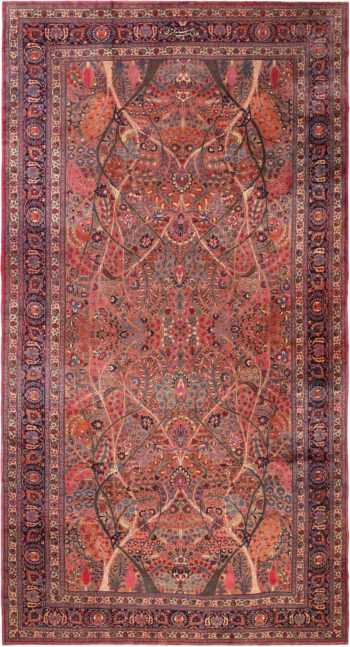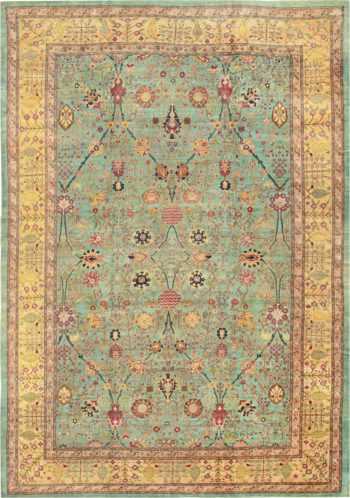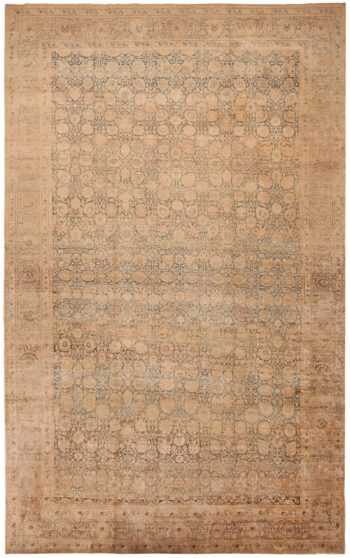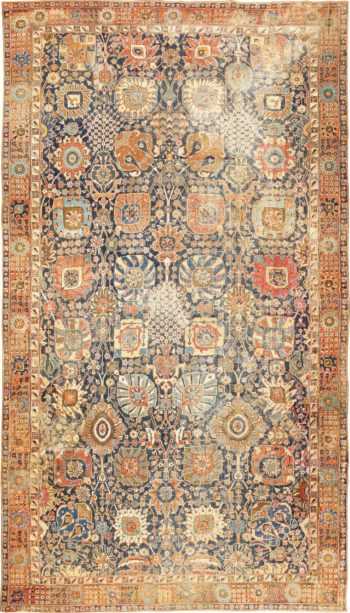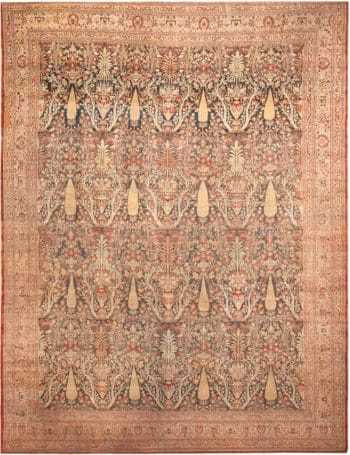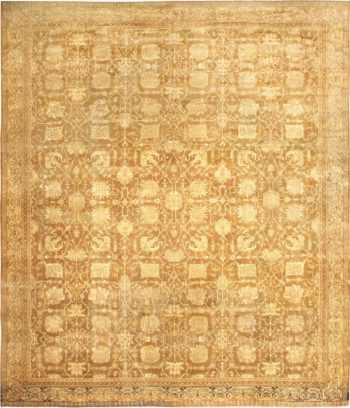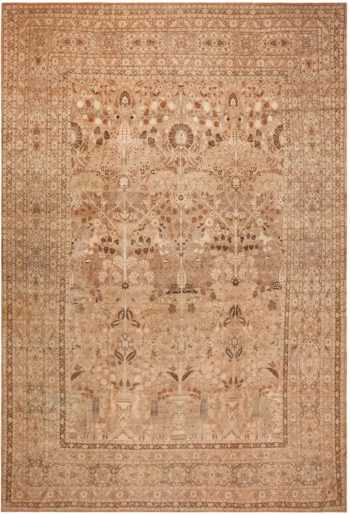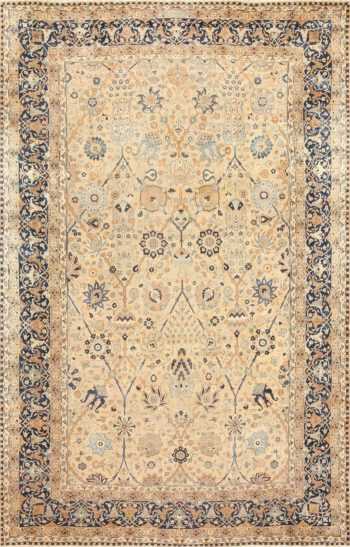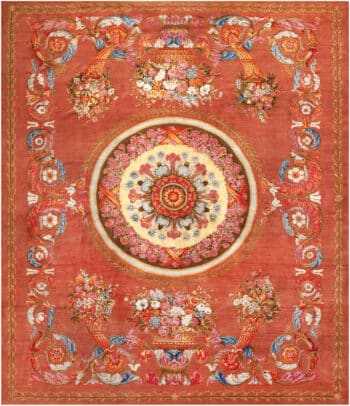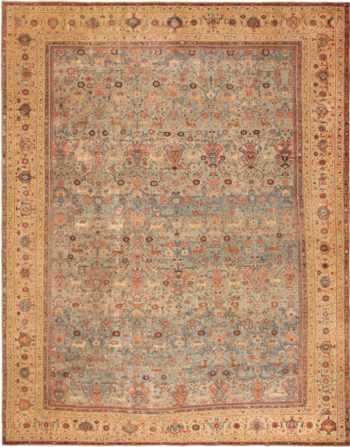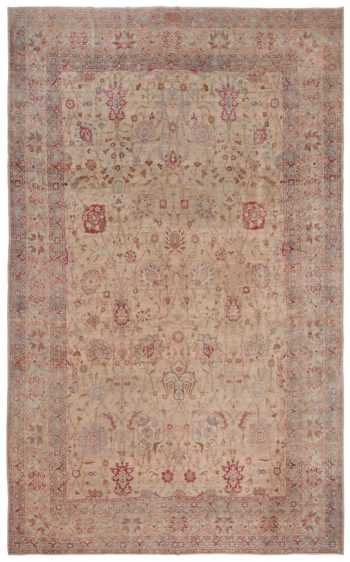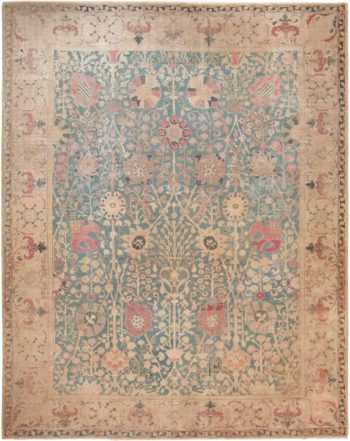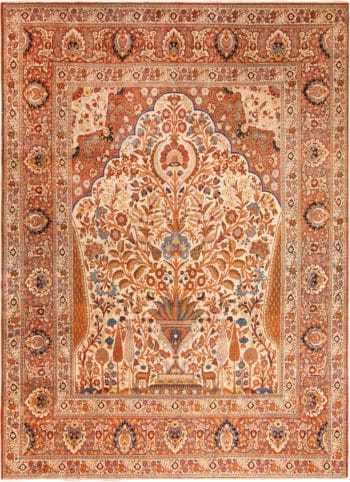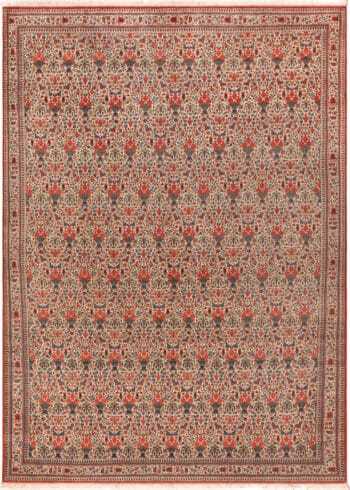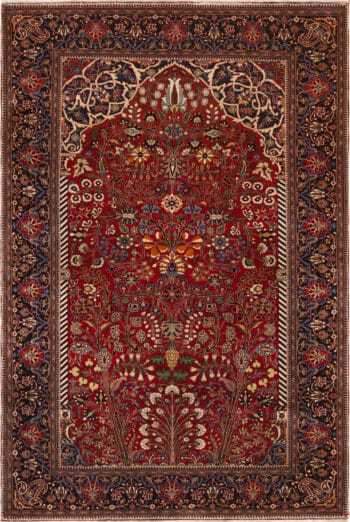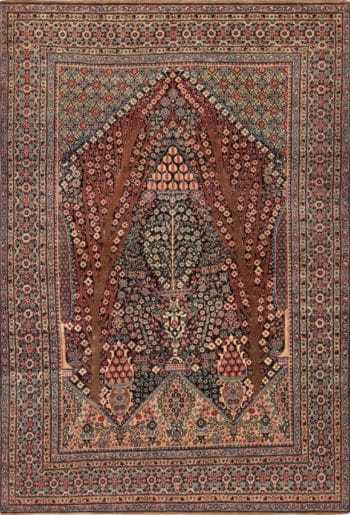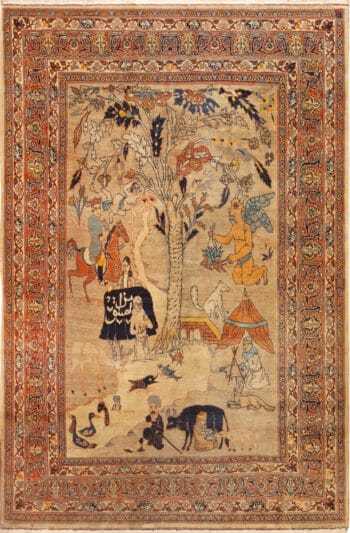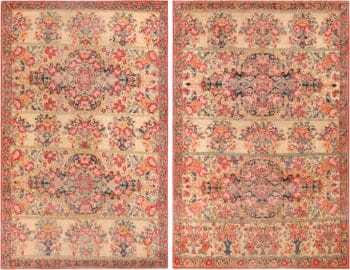Vase Design Rugs
Below you can view our selection of rugs that features the antique Persian vase design:
Fine Floral Tree Of Life Oversized Antique Persian Vase Design Khorassan Garden Rug 71842
$88,000.00Size: 12 ft 10 in x 24 ft 9 in (3.91 m x 7.54 m)Large Oversized Seafoam Color Antique Indian Agra Rug 40317
Size: 15 ft 10 in x 23 ft (4.83 m x 7.01 m)Oversized Antique Persian Tabriz Vase Design Carpet 71475
$185,000.00Size: 12 ft 9 in x 20 ft 3 in (3.89 m x 6.17 m)Oversized Antique Persian Tabriz Vase Design Rug 70517
$96,000.00Size: 12 ft 2 in x 20 ft 2 in (3.71 m x 6.15 m)Antique 17th Century Persian Vase Kerman Carpet 45770
Size: 11 ft 5 in x 20 ft 2 in (3.48 m x 6.15 m)Fine Light Blue Antique Persian Tabriz Haji Jalili Rug 71304
Size: 14 ft 6 in x 19 ft 10 in (4.42 m x 6.05 m)Fine Large Cypress Tree Vase Design Antique Persian Tabriz Rug 72427
Size: 13 ft 8 in x 18 ft 3 in (4.17 m x 5.56 m)Large Antique Vase Design Indian Amritsar Rug 50341
$44,000.00Size: 14 ft 8 in x 17 ft 5 in (4.47 m x 5.31 m)Beautiful Fine Neutral Decorative Large Antique Persian Tabriz Vase Tree Of Life Design Abrash Rug 71992
$39,000.00Size: 11 ft 7 in x 16 ft 8 in (3.53 m x 5.08 m)Large Vase Design Antique Persian Kerman Rug 50701
$36,000.00Size: 10 ft 4 in x 16 ft 6 in (3.15 m x 5.03 m)Spectacular Large Antique French Savonnerie Carpet 72695
Size: 14 ft 4 in x 16 ft 3 in (4.37 m x 4.95 m)Large Antique Persian Animal Design Sultanabad Rug 71476
$88,000.00Size: 12 ft 8 in x 16 ft (3.86 m x 4.88 m)Soft Antique Floral Persian Kerman Vase Design Rug 70375
$34,000.00Size: 9 ft x 14 ft 4 in (2.74 m x 4.37 m)Vase Design Antique Indian Agra Rug 70802
$38,000.00Size: 11 ft x 14 ft 2 in (3.35 m x 4.32 m)Vase Design Antique Persian Kerman Floral Rug 72477
$16,500.00Size: 11 ft 4 in x 14 ft (3.45 m x 4.27 m)Beautiful Fine Antique Floral Vase Tree Of Life Persian Haji Jalili Tabriz Rug 72227
$28,500.00Size: 9 ft 6 in x 12 ft 10 in (2.9 m x 3.91 m)Prayer Design Antique Persian Kerman Floral Rug 72869
$26,500.00Size: 10 ft 8 in x 12 ft 4 in (3.25 m x 3.76 m)Antique Persian Zeleh Sultan Area Rug 72476
$12,500.00Size: 7 ft 10 in x 11 ft 2 in (2.39 m x 3.4 m)Floral Antique Persian Mohtashem Kashan Prayer Design Rug 72854
Size: 4 ft 10 in x 7 ft 2 in (1.47 m x 2.18 m)Antique Pictorial Persian Mohtashem Kashan Rug 72853
Size: 4 ft 8 in x 7 ft 2 in (1.42 m x 2.18 m)Fine Floral Antique Persian Prayer Design Tehran Rug 72456
Size: 4 ft 8 in x 6 ft 10 in (1.42 m x 2.08 m)Antique Persian Tabriz Haji Jalili Pictorial Rug 72866
$14,500.00Size: 4 ft 6 in x 6 ft 7 in (1.37 m x 2.01 m)Fine Quality Pair Of Classic Floral Vase Design Antique Persian Kerman Rugs 72185
$12,750.00Size: 4 ft 3 in x 6 ft 6 in (1.3 m x 1.98 m)Fine Prayer Vase Design Silk Mohtasham Kashan Antique Persian Rug 71618
Size: 4 ft 3 in x 6 ft 6 in (1.3 m x 1.98 m)
Persian Vase Rugs: Bringing the Garden Indoors
An antique Persian vase design rugs bring a garden of color to indoor spaces. Simply speaking, a vase carpet features one or more vases overflowing with flowers that spill across the design. They can either have a single large vase or several smaller vases throughout the design. There is no doubt that they are some of the most striking and beautiful antique Persian carpets in the world.
However, the antique Persian vase rugs from Kerman are even more special, considering their important role in the rise of one of the greatest dynasties in the world.
History of Antique Persian Vase Carpets
Kerman is a city located in, what is today, south central Iran. It became a center of carpet weaving as early as the 15th century and the region produced some of the most prized and highly collectible carpets of today. To the point where one vase rug sold for 10,000,000 while another became the most expensive rug ever sold at auction and brought $34,000,000.
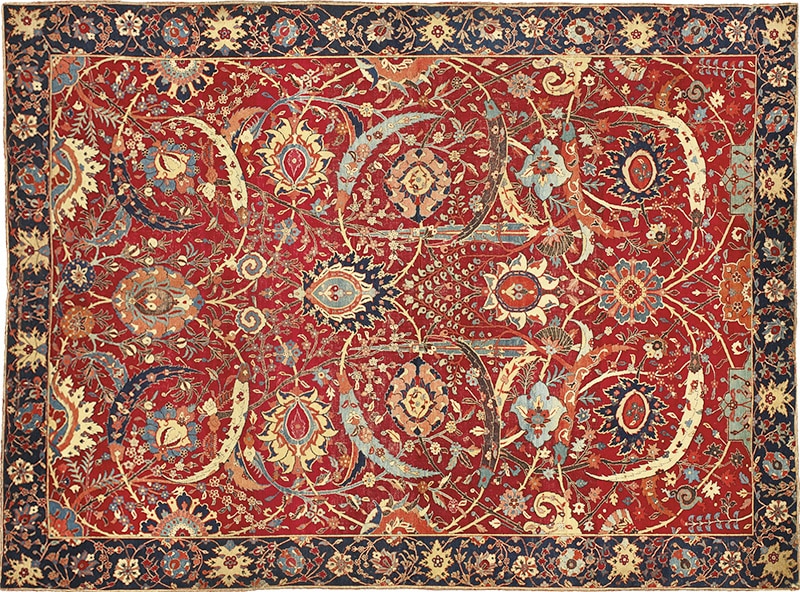
Antique Persian Vase Rug – Most Expensive carpet Sold At Auction
The vase design rugs were most prominent in the 15th and 16th century during the rule of the Safavid Dynasty. The Safavid Dynasty is known as a time of economic revival and the carpet industry was an important part of this economic growth.
The courts of the Safavids were lavishly decorated and intended to draw attention to the wealth and success of the rulers. Many of the artistic designs found throughout the Persian Empire first began with artists commissioned by the courts. The designs later spread throughout the region and were mimicked by the local artisans.
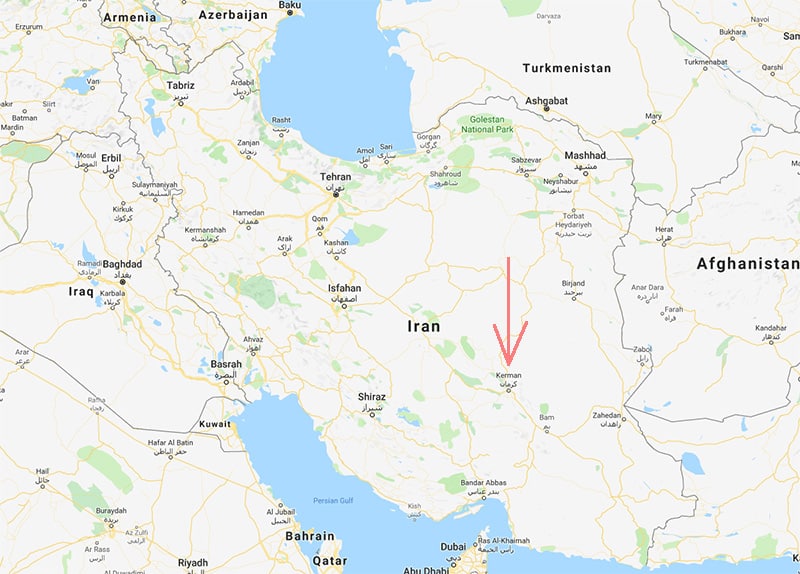
The City Of Kerman In Iran Map
Silk and wool were some of the most valuable commodities that were used to produce goods that the Persians traded along the famed Silk Road. Shah Abbas (1571-1629), recognized the commercial benefit of sponsoring the arts and the production of artisan products, including carpets. Local handicrafts were an important part of foreign trade and the economic power of the Dynasty.
By the 16th century, carpet weaving had evolved from its tribal roots into a thriving industry that produced some of the most exquisite rug designs in the world. The antique Persian Kerman rugs became known for their use of color and design, including the prized antique Persian vase design rugs. Kerman vase carpets were produced during the Golden Age of the Persian Empire and they are still prized today.
Antique Persian Vase Rugs – Weaving Technique and Rug Design
Many of the court artisans produced patterns and drawings to be distributed to the local artisans. The antique rugs were produced in commercial workshops and in private homes. The materials could include cotton, silk, and wool. The dying of the wool become a highly skilled trade to produce colors that were vibrant and long lasting. Although Persian vase carpets of the Safavid and subsequent periods are rare, many times, the colors have remained as bright as when they were first created.

Antique Persian Kerman Vase Carpet
The Kerman vase carpets of the Safavid, and later periods, used a weaving technique that was unique, and later became known as the “vase” technique. The technique involved using three rows of weft of very fine threads between each row of rug knots. Most Kerman carpets use the asymmetrical knot. The first and third rows are high tension and consisted of wool, but the third is left loose and is typically cotton or silk, but sometimes wool as well. This gave the antique Persian Kerman vase carpets their strength and durability. It also gives them a distinctive structure that allows them to catch the light differently and produces a unique sheen and texture that carpets of the region became known for and is easily recognizable.
The colors of the Kerman vase carpets include ivory, royal blues, rich reds, golden and saffron tones. The colors are often rich and harmonious, blending together in a way that creates contrast in the design and highlights elements chosen by the designer.

Vase Design Rug Motif
The floral patterns of the vase carpet are often connected by intricate vine work in a system that has formal geometric form and structure. They were meant to mimic the formal gardens of the Persian courts during the Golden Age. Antique Persian vase rugs continued to be produced through the 18th century, and their design evolved over time. In some instances, the vase itself is not present, only the suggestion of it. In others, the vase became extravagant and oversized.
Some later variations on the vase design rugs include a central medallion with sweeping floral pattern filling the background of the field. At the end of the 19th and early 20th centuries, Kerman experienced a revival as a carpet weaving center, relying on many historical and traditional designs, but combining the elements in new ways. Even in the early 20th century, a hand knotted carpet from Kerman could take up to a year to complete.
To own a a true antique Persian vase rug is to own a true treasure of the world.
Check out our beautiful collection of antique Persian Kerman carpets to add a beautiful and unique design feature to your home or office.
Why are the Persian vase carpets so collectible?
Persian vase carpets, also known as “vase-design” carpets , are not only beautiful examples of Persian rugs, they are highly collectible as well.
Here are some of the reasons why the Persian vase carpets so collectible:
- Artistic Beauty and Design: Persian vase carpets are renowned for their intricate and mesmerizing designs. They often feature a central medallion resembling a vase or a bouquet of flowers, surrounded by elaborate patterns and borders. The harmonious combination of colors, the meticulous craftsmanship, and the artistic finesse of these carpets make them visually captivating and aesthetically pleasing.
- Historical Significance: These carpets carry a rich history that dates back centuries. They are often associated with the opulent courts of Persia (modern-day Iran), where they were created as luxury items for royalty and the elite. Collectors are drawn to the sense of history and the cultural heritage encapsulated within these carpets.
- Rare and Limited Supply: Genuine antique Persian vase carpets are rare and hard to come by. Many of these carpets were produced during specific periods in history, and over time, they have become increasingly scarce due to factors such as natural deterioration, historical events, and limited production. This scarcity drives up their collectibility and value.
- Craftsmanship and Technique: Persian vase carpets are typically handwoven using traditional techniques that require immense skill and expertise. The weaving process involves intricate knotting and attention to detail, resulting in a labor-intensive and time-consuming creation. Collectors appreciate the high level of craftsmanship that goes into each carpet.
- Investment Value: Over the years, many Persian vase carpets have appreciated significantly in value, making them attractive investment pieces for collectors. As their rarity increases and demand persists, the value of these carpets often continues to rise.
- Cultural and Artistic Significance: Persian carpets are considered some of the finest examples of textile artistry in the world. Collectors value these carpets not only for their beauty but also for their representation of cultural heritage and artistic expression.
- Status Symbol: Throughout history, owning Persian carpets, especially those of exceptional quality and design, has been a status symbol. This perception of luxury and prestige adds to their collectability, as people are willing to pay a premium for items associated with social distinction.
- Global Interest and Market Demand: The global interest in art, culture, and history fuels the demand for Persian vase carpets. Collectors from various parts of the world appreciate the aesthetic and historical aspects of these carpets, contributing to a robust market for their trade and sale.
While Persian vase carpets are highly collectible, their value and desirability can vary based on factors such as age, condition, rarity, provenance and overall aesthetic appeal. As with any collectible item, potential buyers should conduct thorough research and seek expert advice to make informed decisions.
View some of our favorite Persian vase design area rugs:
This rug blog about antique Persian vase rugs was published by Nazmiyal Antique Rug Gallery in NYC

